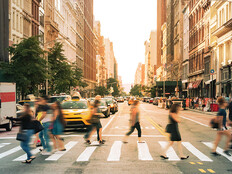What Is a Smart Street Lighting System?
Smart city streetlights, or simply smart streetlights, are streetlights that have generally been upgraded to LED bulbs, which consume far less energy than traditional incandescent bulbs. Philips, one of the leading smart streetlight vendors, says cities can reduce energy use by up to 50 percent with connected lighting. This is critical because, as Cisco notes, streetlights can add up to 38 percent of a city’s utility bill.
Streetlights that can be remotely managed, or automatically dim or turn off based on a lack of activity nearby, can save cities money. LED lights are also brighter than traditional lights, increasing public safety by making traditionally dark areas of cities brighter.
Chicago is in the midst of installing 40,000 new LED streetlights in neighborhoods across the city. The city said in 2019 that it will save an estimated $100 million over the next decade thanks to the energy efficient new lights, which consume 50 to 75 percent less electricity than outdated high-pressure sodium streetlights.
At the same time, as the website Smart City Lab notes, smart lighting has been “recognized as one of the most actionable and ready-to-implement technologies for cities to transition to a low-carbon economy and peak emissions in the next decade.”
Lampposts retrofitted with LED lamps are also “the ideal infrastructure for mounting smart city systems” the site notes, and “when used for networking and monitoring, they become a sensor platform, growing efficiency even further and providing vital data for a myriad of urban solutions.”
Glenn Buck, manager of sales engineers for Transition Networks, writing in Smart Cities Dive, notes that the “street lamppost of the future will do much more than light the streets at night.”
Smart streetlights can support solar power capabilities, digital signage, environmental condition monitoring (temperature, humidity, flood conditions, air quality), as well as traffic monitoring.
This data, transmitted over a light sensory network, “is capable of supporting many city services and initiatives across a single common infrastructure: from law enforcement to environmental improvement, transportation oversight and earthquake preparedness,” Cisco notes.
What Is a Streetlight Management System?
A smart streetlight system involves a cluster of streetlights that “can communicate with each other and provide lighting data to a local concentrator,” according to embedded wireless firm Radiocrafts.
The concentrator then “manages and transmits the relevant data to a secure server that captures the data and presents it in a web-browser dashboard.”
A smart streetlight management system also incorporates two-way communication that allows utility or facility managers to “remotely control streetlights while keeping track of electrical power consumption in the lamps and in the driving circuits.”
Such monitoring helps cut down on maintenance costs, since each streetlight has a unique ID and can be pinpointed. If a connected streetlamp breaks, tips over because of the weather or malfunctions, city workers can schedule maintenance for that specific lamppost.












